Gaining An R.A.F Pilots Brevet In WW II
The A1 might have had a prodigious title in those days, The Great North Road, but it scarcely lived up to it save for the amount of traffic, particularly commercial, that it carried on its many single carriageway sections.
Four fellow Cranwell cadets, crammed into a Mini, were lucky to survive a head-on collision with a British Road Services lorry in the Stamford area. Those in the front were saved by the full harness Irving safety belts (a rare innovation back then), while those in the rear were at least restrained by the front seat backs not folding up with their occupants. As it was the engine moved aft into the passenger cabin. The upshot was a loss of aircrew status for at least one of them, but it could have been so much worse...
The Minor's party piece that you describe, Danny, must have greatly alarmed its occupants, but in its favour I would like to say that it was at least the overtaking vehicle in that case. How many of us have been stuck in a line of vehicles behind one, maintaining a steady 30mph on a clear unrestricted single carriageway road? Perhaps though it is a measure of the appeal the marque has to those who would do all their motoring at 30mph or less rather than of the car itself. If #2 is also of a similar disposition you are doomed to convoy with them until they finally go their separate ways. Better that than to try the desperate manoeuvre that you so vividly describe!
Four fellow Cranwell cadets, crammed into a Mini, were lucky to survive a head-on collision with a British Road Services lorry in the Stamford area. Those in the front were saved by the full harness Irving safety belts (a rare innovation back then), while those in the rear were at least restrained by the front seat backs not folding up with their occupants. As it was the engine moved aft into the passenger cabin. The upshot was a loss of aircrew status for at least one of them, but it could have been so much worse...
The Minor's party piece that you describe, Danny, must have greatly alarmed its occupants, but in its favour I would like to say that it was at least the overtaking vehicle in that case. How many of us have been stuck in a line of vehicles behind one, maintaining a steady 30mph on a clear unrestricted single carriageway road? Perhaps though it is a measure of the appeal the marque has to those who would do all their motoring at 30mph or less rather than of the car itself. If #2 is also of a similar disposition you are doomed to convoy with them until they finally go their separate ways. Better that than to try the desperate manoeuvre that you so vividly describe!
Guest
Posts: n/a
Keep Death off the Road !
Pom Pax,
Your: "... Apparently work had started in 1939 but had not yet recommenced....". Nothing much has changed since......D.
Chugalug,
Your: "....Those in the front were saved by the full harness Irving safety belts (a rare innovation back then)...."
Yes, indeed. No doubt they were rather expensive to buy. But over on the far side of your field the Fire Section would have practice rescue hulks, it was a pity to see the four-point pilot harnesses burn with the dummy when a fire got the better of our brave lads (as did happen from time to time). They weren't guarded at night, you'd only need a pair of strong wirecutters.... How useful they'd be, and how nice they'd look in the cockpit of your TR3, MGB (dare I say Mini ?), etc.
Commander (Air) had really to hammer the table to discourage these endeavours !
Ah, the impetuosity of youth ! While I share with you your irritation at the mobile obstructions (mostly wearing flat-'ats - as indeed I do myself) that are an increasing feature of today's roads, demography points to an increase in their number as the years go by.
So, short of having a maximum age for driving licences (and I believe there are some centenarians who still have them), we have to put up with the old fellas yet. There are advantages. Consider:
Suppose your "open road" cruising speed to be V mph. Then the severity of the prang will relate to ½mV² - yes ? But your give-and-take average speed will be around 6√V mph. (Motorways: 7-8√V mph, according to traffic conditions.) Strange but true ! (Authority - 75 years driving experience). So twice as fast will give you four times the whack on the head , but you only cover 1.414 (?) times the distance on the ground
, but you only cover 1.414 (?) times the distance on the ground  . It's not a fair swap.
. It's not a fair swap.
Festina Lente !....D. (hasten slowly)
Cheers, both. Danny.
Your: "... Apparently work had started in 1939 but had not yet recommenced....". Nothing much has changed since......D.
Chugalug,
Your: "....Those in the front were saved by the full harness Irving safety belts (a rare innovation back then)...."
Yes, indeed. No doubt they were rather expensive to buy. But over on the far side of your field the Fire Section would have practice rescue hulks, it was a pity to see the four-point pilot harnesses burn with the dummy when a fire got the better of our brave lads (as did happen from time to time). They weren't guarded at night, you'd only need a pair of strong wirecutters.... How useful they'd be, and how nice they'd look in the cockpit of your TR3, MGB (dare I say Mini ?), etc.
Commander (Air) had really to hammer the table to discourage these endeavours !
Ah, the impetuosity of youth ! While I share with you your irritation at the mobile obstructions (mostly wearing flat-'ats - as indeed I do myself) that are an increasing feature of today's roads, demography points to an increase in their number as the years go by.
So, short of having a maximum age for driving licences (and I believe there are some centenarians who still have them), we have to put up with the old fellas yet. There are advantages. Consider:
Suppose your "open road" cruising speed to be V mph. Then the severity of the prang will relate to ½mV² - yes ? But your give-and-take average speed will be around 6√V mph. (Motorways: 7-8√V mph, according to traffic conditions.) Strange but true ! (Authority - 75 years driving experience). So twice as fast will give you four times the whack on the head
 , but you only cover 1.414 (?) times the distance on the ground
, but you only cover 1.414 (?) times the distance on the ground  . It's not a fair swap.
. It's not a fair swap.Festina Lente !....D. (hasten slowly)
Cheers, both. Danny.
Join Date: Oct 1998
Location: Kalgoorlie, W.A. , Australia
Age: 86
Posts: 458
Likes: 0
Received 0 Likes
on
0 Posts
full harness Irving safety belts
When I motored seriously I had 3 sets of full harness. Firstly a very crude and cumbersome type, IIRC of Britax origin. Then as my ambitions became more serious an Irving set.
Danny you have a suspicious mind!
Yes they were more expensive but not that much more than Britax. The straps were softer than anything I have experienced before or since and release so simply, 1 finger flip. They had a 3 point anchorage which made life inconvenient for a back seat passenger and a single tensioner. For my navigator I had a conventional three point belt but still Irving, same release, same soft webbing and easy tensioner.
When I got very serious it was back to Britax, (I think Irving had gone out of the car market) reasonable but coarser harness, 2 tensioners and a more complicated release. Also no longer inconvenient for a back seat passenger but impossible! Of course the advancing commercialisation of motorsport did mean discounts and bonuses. However the left hand seat kept its comfortable Irving.
Danny you have a suspicious mind!
No doubt they were rather expensive to buy. But over on the far side of your field the Fire Section..........
When I got very serious it was back to Britax, (I think Irving had gone out of the car market) reasonable but coarser harness, 2 tensioners and a more complicated release. Also no longer inconvenient for a back seat passenger but impossible! Of course the advancing commercialisation of motorsport did mean discounts and bonuses. However the left hand seat kept its comfortable Irving.
Guest
Posts: n/a
Danny says "Where my Caravan hath Rested"
First, you must Go on a Course, for it is a fixed belief in the RAF that anybody can do anything so long as they have Been on a Course. At that time the RAF Fire Service were based at RAF Catterick. I think the Course was for a fortnight, full time, so I must have been detached from Linton for the purpose.
Now from where did I commute ? I think that we were still in N.Yorkshire, for I remember the run across country to Catterick (30 mi) would take about 40 mins, and that seems about what I remember for the journey. We reckon that we stayed in Marton until the end of November, then decamped temporarily to the Westminster Hotel at Clifton (north end of York), for winter was coming (and what a winter it would prove to be !) and it was only 10 miles from Linton.
It was a cosy and comfortable little place (and we stayed almost to Christmas there). The first snows had come, and our next move was to a hiring in "The Paddock" a little cul-de-sac of semis out on the Boroughbridge Road in York. We were not far from a giant sugar-beet factory some way behind the houses. As the product is sugar, you might suppose sweet airs would always emanate from the place - well, they don't. But otherwise it was a fair enough spot; there were plenty of small shops nearby; York (about 4 miles) was handy enough for big shopping, besides being a fabulous piece of history to explore.
One journey of that time will live with me always. We wanted both our mothers and Iris's brother to spend Christmas ('62) with us in the Paddock, so I went across to the Wirral to bring mine. There had been a dump of snow, the Pennines were covered, but the lower main roads were clear and dry. My route I knew like the back of my hand - Liverpool, Preston, Skipton, Blubberhouses, Harrogate, York...... Easy.
I picked mother up, and started back in the sunny afternoon. Five miles short of Preston the screen went. There were no cars running ahead or oncoming past me - it couldn't have been a stone strike. It was very cold outside, the heater had been going full blast. Perhaps thermal stress ? But though all the screen was "crumbled", it held in place. Gingerly I poked out a hole about ten inches across, just enough to see through, and crept into Preston.
Halford's was not hard to find; celluloid sheet on the shelf (sidescreen and rear windows for the sidecars and sports cars of those days). Cut a piece to size with a wide overlap to cover the hole, sellotape to outside of screen, cup of tea, back on the road again. I was taking a chance that there would be no more rain or snow, for I daren't use the wipers.
We started to climb, soon it was white underfoot as I slowly and steadily weaved round the hill bends to the flat top of the Pennines. There was no traffic, it was full dark now and very lonely on the moors! At last we began to reach the long downhill straights into Harrogate, bright lights again, only twenty miles to go now. Piece of cake ! Gladstone Garages, Layerthorpe (Àgence Peugeot, York) put a new screen in, but I was finding bits of glass crumb in hidden corners of the car for ages. Then we had a lovely, happy Christmas !
There had been heavy snow over the holiday, but by now the "Winter of the
Century" ('62/'63) had all Britain in its grip. A giant "high" was stationary over the British Isles, for about six weeks the temperature in the NE didn't rise above freezing day or night. Birds froze to the branchs in the trees. The earth was iron-hard, you couldn't get a spade into it to raise a root vegetable (we had a back garden full of parsnips, but could hardly get one out). The only saving grace was: there was some thin sunshine and little or no wind.
Ironically, if there had been wind-farms at that time, you wouldn't have got a single Kwh out of any of them - (with the load on the grid at its peak - our house was crammed with electric fires). No one who lived through that winter will ever forget it.
We were there till early summer, then a MQ was offered to us - at Breighton ! This was right out in the wilds, some 15 mi SE of York. An old bomber station, it had enjoyed a brief new life as a Bloodhound site until they finished, too. But in that time they'd built one OMQ - a S/Ldr's house for the CO - and when he went the house was dumped on Linton to look after. But being at the back of beyond, it had found no takers.
We had a look at it, and reasoned thus: Mary had only just turned three; schools were not a pressing problem. It was very quiet, about a mile outside Bubwith village. There was no traffic. Mary had graduated to her first "proper" bike (on stabilisers !) by then. The house had plenty of room, and a big garden surrounded by farmland. York was only 30 minutes away, Selby in easy reach. We decided to take it.
Next time I really must say something about the Fire Course and (what was it, now ?)...... Oh yes - Linton-on-Ouse !
Good night, all,
Danny 42C.
"Let Nothing ye Dismay"
PS: Smudge, I suppose "Take your time" or "Don't hurry" would be about right. Danny.
Now from where did I commute ? I think that we were still in N.Yorkshire, for I remember the run across country to Catterick (30 mi) would take about 40 mins, and that seems about what I remember for the journey. We reckon that we stayed in Marton until the end of November, then decamped temporarily to the Westminster Hotel at Clifton (north end of York), for winter was coming (and what a winter it would prove to be !) and it was only 10 miles from Linton.
It was a cosy and comfortable little place (and we stayed almost to Christmas there). The first snows had come, and our next move was to a hiring in "The Paddock" a little cul-de-sac of semis out on the Boroughbridge Road in York. We were not far from a giant sugar-beet factory some way behind the houses. As the product is sugar, you might suppose sweet airs would always emanate from the place - well, they don't. But otherwise it was a fair enough spot; there were plenty of small shops nearby; York (about 4 miles) was handy enough for big shopping, besides being a fabulous piece of history to explore.
One journey of that time will live with me always. We wanted both our mothers and Iris's brother to spend Christmas ('62) with us in the Paddock, so I went across to the Wirral to bring mine. There had been a dump of snow, the Pennines were covered, but the lower main roads were clear and dry. My route I knew like the back of my hand - Liverpool, Preston, Skipton, Blubberhouses, Harrogate, York...... Easy.
I picked mother up, and started back in the sunny afternoon. Five miles short of Preston the screen went. There were no cars running ahead or oncoming past me - it couldn't have been a stone strike. It was very cold outside, the heater had been going full blast. Perhaps thermal stress ? But though all the screen was "crumbled", it held in place. Gingerly I poked out a hole about ten inches across, just enough to see through, and crept into Preston.
Halford's was not hard to find; celluloid sheet on the shelf (sidescreen and rear windows for the sidecars and sports cars of those days). Cut a piece to size with a wide overlap to cover the hole, sellotape to outside of screen, cup of tea, back on the road again. I was taking a chance that there would be no more rain or snow, for I daren't use the wipers.
We started to climb, soon it was white underfoot as I slowly and steadily weaved round the hill bends to the flat top of the Pennines. There was no traffic, it was full dark now and very lonely on the moors! At last we began to reach the long downhill straights into Harrogate, bright lights again, only twenty miles to go now. Piece of cake ! Gladstone Garages, Layerthorpe (Àgence Peugeot, York) put a new screen in, but I was finding bits of glass crumb in hidden corners of the car for ages. Then we had a lovely, happy Christmas !
There had been heavy snow over the holiday, but by now the "Winter of the
Century" ('62/'63) had all Britain in its grip. A giant "high" was stationary over the British Isles, for about six weeks the temperature in the NE didn't rise above freezing day or night. Birds froze to the branchs in the trees. The earth was iron-hard, you couldn't get a spade into it to raise a root vegetable (we had a back garden full of parsnips, but could hardly get one out). The only saving grace was: there was some thin sunshine and little or no wind.
Ironically, if there had been wind-farms at that time, you wouldn't have got a single Kwh out of any of them - (with the load on the grid at its peak - our house was crammed with electric fires). No one who lived through that winter will ever forget it.
We were there till early summer, then a MQ was offered to us - at Breighton ! This was right out in the wilds, some 15 mi SE of York. An old bomber station, it had enjoyed a brief new life as a Bloodhound site until they finished, too. But in that time they'd built one OMQ - a S/Ldr's house for the CO - and when he went the house was dumped on Linton to look after. But being at the back of beyond, it had found no takers.
We had a look at it, and reasoned thus: Mary had only just turned three; schools were not a pressing problem. It was very quiet, about a mile outside Bubwith village. There was no traffic. Mary had graduated to her first "proper" bike (on stabilisers !) by then. The house had plenty of room, and a big garden surrounded by farmland. York was only 30 minutes away, Selby in easy reach. We decided to take it.
Next time I really must say something about the Fire Course and (what was it, now ?)...... Oh yes - Linton-on-Ouse !
Good night, all,
Danny 42C.
"Let Nothing ye Dismay"
PS: Smudge, I suppose "Take your time" or "Don't hurry" would be about right. Danny.
Last edited by Danny42C; 27th Feb 2014 at 21:20. Reason: Insert text.
Guest
Posts: n/a
Union Jack and Smudge,
UJ, might that be the one which ends : "Let's stroll across and have the lot ?"....D.
Smudge,
You're right about the oxymoron, of course, but the "ox" connection is a new one on me. Highly ingenious for all that ! What UJ and I are thinking about (if I'm right) concerns the Desirability of Conservation of Energy...D.
Time for bed. Cheers, both. Danny.
UJ, might that be the one which ends : "Let's stroll across and have the lot ?"....D.
Smudge,
You're right about the oxymoron, of course, but the "ox" connection is a new one on me. Highly ingenious for all that ! What UJ and I are thinking about (if I'm right) concerns the Desirability of Conservation of Energy...D.
Time for bed. Cheers, both. Danny.
Sorry Danny,
Just a pun on UJs reference to bulls, I assumed that Oxen males were also called bulls, therefore Oxymoron (Ox). Must brush up on my knowledge of cloven footed beasts. Meanwhile, back to the fray !!!
Smudge
Just a pun on UJs reference to bulls, I assumed that Oxen males were also called bulls, therefore Oxymoron (Ox). Must brush up on my knowledge of cloven footed beasts. Meanwhile, back to the fray !!!
Smudge

Join Date: Mar 2010
Location: Often in Jersey, but mainly in the past.
Age: 79
Posts: 7,810
Received 136 Likes
on
64 Posts
Danny42C, 63/64 was foul as well ... I was at BRNC at the time, and found myself in sick bay for some reason. Mates were coming in from 'Leadership' exercises (aka 'Survival', as there were never any DS present to assess any form of leadership) on Dartmoor with frostbite. Nicely timed sickness, whatever it was! 
However, I jump ahead. Apologies.

However, I jump ahead. Apologies.
Danny
"Let's stroll across and have the lot?"
It certainly might!
Smudge
Oxymoron/Meanwhile, back to the fray !!!
Very good/Presumably Fray Bentos in this case?
Jack
"Let's stroll across and have the lot?"
It certainly might!

Smudge
Oxymoron/Meanwhile, back to the fray !!!
Very good/Presumably Fray Bentos in this case?

Jack
Guest
Posts: n/a
Smudgsmith,
Now no "Sorry" about it, Smudge. In fact it illustrates that you have the aptitude for lateral thinking that enables people to breeze through the D.T. crossword in half-an-hour.
Now I am sure that Union Jack (if asked nicely) will tell the tale of "The Old Bull and the Young Bull" for the edification of you youngsters. UJ, isn't it marvellous how the passage of time now enables us to retell all our old jokes and tales to a fresh audience ?....D.
MPN11,
Again, no apology necessary ! Indeed it confirms my recall of the weather on an occasion (to be related in a not-so-distant Post) when my "Isetta" exchanged fisticuffs with a RAF J2 van (but that, as they say, is a Story for Another Day).
I've always thought that a Society for the Prevention of Cruelty to Military Cadets should have been formed long ago (but I managed to dodge that column). Your DS should have demonstrated leadership and got frostbitten with you !...D.
Your DS should have demonstrated leadership and got frostbitten with you !...D.
Back to the nitty-gritty next Post. Cheers, Danny.
PS: Crossed in the Post, UJ !
Now no "Sorry" about it, Smudge. In fact it illustrates that you have the aptitude for lateral thinking that enables people to breeze through the D.T. crossword in half-an-hour.
Now I am sure that Union Jack (if asked nicely) will tell the tale of "The Old Bull and the Young Bull" for the edification of you youngsters. UJ, isn't it marvellous how the passage of time now enables us to retell all our old jokes and tales to a fresh audience ?....D.
MPN11,
Again, no apology necessary ! Indeed it confirms my recall of the weather on an occasion (to be related in a not-so-distant Post) when my "Isetta" exchanged fisticuffs with a RAF J2 van (but that, as they say, is a Story for Another Day).
I've always thought that a Society for the Prevention of Cruelty to Military Cadets should have been formed long ago (but I managed to dodge that column).
 Your DS should have demonstrated leadership and got frostbitten with you !...D.
Your DS should have demonstrated leadership and got frostbitten with you !...D.Back to the nitty-gritty next Post. Cheers, Danny.
PS: Crossed in the Post, UJ !
Last edited by Danny42C; 28th Feb 2014 at 22:19. Reason: Add Text.
Guest
Posts: n/a
ricardian,
This is more like it (shamelessly lifted from "The Decca Legacy").
6.2. TYPE 424 (AIRFIELD CONTROL RADAR)
The 424 Airfield Control Radar was designed in 1952 to meet an RAF requirement for an ‘Approach Radar’. It was designated by the RAF as the ACR7D (note that Cossor also produced a radar to meet the requirement and their equipment was designated the ACR7C. It is thought that only 6 systems of this type went into service). Operating at 3cms wavelength (X-band) the first version used a 14ft. single curvature antenna fed by a ‘hoghorn’. Later versions (including the Circular Polarisation variant) used an antenna curved in both planes, but each plane following the same mathematical law, which in the profession is known as ‘an orange peel reflector’ (as against a ‘double curvature’ reflector which follows differing mathematical laws in the vertical and horizontal) and was fed by a horn. The antenna was mounted on a transmitter box (housing 2 transmitters), which in turn was mounted on a turning gear (shades of the Type 159 marine radar from which it was derived). The 20Kw transmitter operated with a pulse length of either 0.1 or 0.5 microseconds at a prf of 1000pps. The PPI displays were of the 12inch rotating coil type similar to those used in the Type 45 Marine Radar. Both mobile and transportable versions were produced.
The mobile version was mounted on a ‘Karrier’ (Rootes Group) ‘Gamecock’ chassis, which had quite small road wheels to minimise the overall height. Two models only were produced. One painted in red and white stripes as a demonstrator for the UK market, it became a general trials vehicle. The other, painted yellow for export demonstrations, was eventually sold to Argentina.
The transportable version used an aluminum cast pedestal, with outriggers giving stability to the antenna and turning gear. The Displays, the Control Panel and the two Receiver Units were mounted on a folding table in the operations room/cabin.


In the mid 1950’s a 424, of the Airfield Control type, was sold to the Vickers Aircraft Company and was installed at their test airfield at Wisley in Surrey.
TYPE 424 Airfield Control Radars were supplied to over 45 Civil and Military Authorities, a quantity of 22 in the UK and others to countries such as India, New Zealand, Ceylon and Brazil. Total sales were approximately 125.

This is much like what I remember of the inside of our van (which IIRC looked like the back half chopped off the mobile above).
I can only remember one tube (not sure which one). But it was 50 years ago, and memory fades. .........D.
.........D.
This is more like it (shamelessly lifted from "The Decca Legacy").
6.2. TYPE 424 (AIRFIELD CONTROL RADAR)
The 424 Airfield Control Radar was designed in 1952 to meet an RAF requirement for an ‘Approach Radar’. It was designated by the RAF as the ACR7D (note that Cossor also produced a radar to meet the requirement and their equipment was designated the ACR7C. It is thought that only 6 systems of this type went into service). Operating at 3cms wavelength (X-band) the first version used a 14ft. single curvature antenna fed by a ‘hoghorn’. Later versions (including the Circular Polarisation variant) used an antenna curved in both planes, but each plane following the same mathematical law, which in the profession is known as ‘an orange peel reflector’ (as against a ‘double curvature’ reflector which follows differing mathematical laws in the vertical and horizontal) and was fed by a horn. The antenna was mounted on a transmitter box (housing 2 transmitters), which in turn was mounted on a turning gear (shades of the Type 159 marine radar from which it was derived). The 20Kw transmitter operated with a pulse length of either 0.1 or 0.5 microseconds at a prf of 1000pps. The PPI displays were of the 12inch rotating coil type similar to those used in the Type 45 Marine Radar. Both mobile and transportable versions were produced.
The mobile version was mounted on a ‘Karrier’ (Rootes Group) ‘Gamecock’ chassis, which had quite small road wheels to minimise the overall height. Two models only were produced. One painted in red and white stripes as a demonstrator for the UK market, it became a general trials vehicle. The other, painted yellow for export demonstrations, was eventually sold to Argentina.
The transportable version used an aluminum cast pedestal, with outriggers giving stability to the antenna and turning gear. The Displays, the Control Panel and the two Receiver Units were mounted on a folding table in the operations room/cabin.


In the mid 1950’s a 424, of the Airfield Control type, was sold to the Vickers Aircraft Company and was installed at their test airfield at Wisley in Surrey.
TYPE 424 Airfield Control Radars were supplied to over 45 Civil and Military Authorities, a quantity of 22 in the UK and others to countries such as India, New Zealand, Ceylon and Brazil. Total sales were approximately 125.

This is much like what I remember of the inside of our van (which IIRC looked like the back half chopped off the mobile above).
I can only remember one tube (not sure which one). But it was 50 years ago, and memory fades.
 .........D.
.........D.
I enjoyed the BBC radio interview, broadcast 0930 today, with North Yorkshire author and WWII Lancaster pilot Bill Spence, marking his nomination for a literary award. He sounded very fit, and like one who might really enjoy popping into this unique crewroom if some Nav could point him in the right direction.
Unfortunately Ampleforth is way out of range for me ....
Unfortunately Ampleforth is way out of range for me ....
I recall that sadly a cadet on 89 Entry, Martin Barents, lost his life when a "cadet" car came off the Ancaster road just off the A! near the chip factory. After that all cadet owned cars of whatever age (and however difficult it was) had to have seat belts fitted.
PS - Anyone know why the 69 Entry web site has stopped working. I am sure it was OK last week - seems OK again tonight (Sunday)
PS - Anyone know why the 69 Entry web site has stopped working. I am sure it was OK last week - seems OK again tonight (Sunday)
Last edited by Wander00; 2nd Mar 2014 at 17:10. Reason: Another thought , and another
Guest
Posts: n/a
TO ALL IT WHOM IT MAY CONCERN
For some time past I've been pointing a few of my friends in the direction of PPRuNe and this Thread, particularly recommending (on a paper slip) two or three of particular interest (as I thought).
It now seems that the Thread Pages and/or Post Numbers I quoted have been amended by PPRuNe as follows:
[Page/Post Number]
For 113/2250 (my first Post) read 114/2262.
For 128/2549 (video of VVs posted by Chugalug), read 129/2561.
" ...110/2200 (Blind Landing a Vulcan at LHR) posted by Padhist read 111/2212.
"... 143/2848, 144/2866 and 146/2908 (my write-off), read
......143/2860, 144/2878 and 146/2920.
" ....35/691 (Business Ethics) posted by regle, read 35/692.
Danny42C
PS: Other PPRuNers, check any Pages/Post Numbers you may have on record and intend to quote to third parties.....Anybody know why this happens ?...D.
It now seems that the Thread Pages and/or Post Numbers I quoted have been amended by PPRuNe as follows:
[Page/Post Number]
For 113/2250 (my first Post) read 114/2262.
For 128/2549 (video of VVs posted by Chugalug), read 129/2561.
" ...110/2200 (Blind Landing a Vulcan at LHR) posted by Padhist read 111/2212.
"... 143/2848, 144/2866 and 146/2908 (my write-off), read
......143/2860, 144/2878 and 146/2920.
" ....35/691 (Business Ethics) posted by regle, read 35/692.
Danny42C
PS: Other PPRuNers, check any Pages/Post Numbers you may have on record and intend to quote to third parties.....Anybody know why this happens ?...D.
Last edited by Danny42C; 2nd Mar 2014 at 19:17. Reason: Add Text
Fasching or Karneval (Carnival)
Danny in his earlier missives above provided a good background to R.A.F. service life in Germany in the 1960’s. However he didn’t mention Fasching or Karneval (Carnival) that made for a refreshing change of mood for what we Brits perceived as the sometimes very serious disposition of many Germans in the towns and cities in the Rhineland and the ones we worked alongside at JHQ.
So the start of Lent next week reminds me of the habit in towns in the Rhineland to hold their carnival processions. In the big towns or cities such as Cologne or Dusseldorf Rosenmontag (Rose Monday) is the highlight of the German “Karneval” (carnival) season and is on the Monday before Ash Wednesday. Celebrations become quieter the next day, known as Veilchendienstag (“Violet Tuesday”, (Shrove Tuesday)), and end on "Aschermittwoch” (Ash Wednesday). Monchengladbach’s carnival procession titled Veilchendienstagszug (Violet Tuesday Train) traditionally takes place on the Tuesday and JHQ some other units in the area treated the day as a holiday so we all had the day off, which was ideal as the BFG School was closed too and the kids had the day off as well and were keen to participate in the celebrations.
Traditionally, as I recorded alongside the photos in my photo album, the 1973 carnival procession consisted of 80 floats, 30 marching bands, and 24 dance troupes. I took my kids and a couple of neighbours kids from our MG married quarter patch to enjoy the procession – forewarned that kids should have bags to catch the sweets (Kamelle) thrown from the carnival floats into the crowds lining the streets among cries of “Helau” or “Alaaf”. The kids were not disappointed and came back well laden. Mum was also rewarded because flowers (tulips) were thrown into the crowd too. As seen the kids were dressed and made up to blend in with the German crowd.
Many girls in the parade “Tanzmariechen” or “Funkenmariechen” (marching girls) wear a very fetching uniform styled outfit. This consists of a very short skirt copied from 18th Century designs. Originally worn as jacket and trousers the trousers evolved into a short dress with a pleated skirt and very frilly knickers (to maintain their modesty as they “high-kicked” their legs through town). A wig with braided pigtails was worn and on top of that a Tricorn hat. White boots finished off the outfit.
Many of the dancers (“fools”) perform energetic dances emulating St Vitus, whose name is given to the Monastery after which Mönchengladbach is named. The Monastery of St. Vitus is a large Roman Catholic Church / Abbey set high on a hill overlooking the town. The Karneval traditionally has floats of “fools” or troops of dancers who emulate St Vitus in their mad dancing. According to legend, if suffering from various ailments one would say a prayer to the early Christian martyr St Vitus, and your prayer would be answered. St Vitus is reputed to have miraculous healing powers especially for those suffering from seizures, epilepsy, rabies, Sydenham’s chorea (St Vitus Dance), bedwetting, and snakebite, he is also said to protect against lightning strikes, animal attacks and oversleeping! To add to his attributes he is the patron saint of pharmacists, innkeepers, brewers, wine makers, coppersmiths, dancers and actors.
As for military participation in the procession JHQ Rheindahlen was represented by a float as was 79 Sqn Royal Corps of Transport based at Ayrshire barracks in Moenchengladbach. 79 Sqn RCT was responsible for administering the British Military Train “The Berliner” that at the time ran through the Soviet Zone to Berlin, they were also responsible for the various military ambulance trains positioned in sidings at R.A.F. Wildenrath. The RCT “float” was appropriately in the form of a locomotive sporting a Union Jack.
Carnival preparations traditionally begin in November with the election of officials etc. to run the carnival. The carnival celebrations proper kick off just before Lent with the “Women’s Carnival” on the Thursday of the week before Ash Wednesday. This is a special day for women called “Altweiber” (Old Women) or “Weiberfastnacht” (Women’s Day). On this day women are allowed to kiss any man they like as long as they cut off his tie beforehand (Tip: Beware any mad-looking women wielding a pair of scissors!) unless of course you fancy the lady in question in which case wear a very old tie!
German friends tell me Weiberfastnacht has morphed into a more modern form as an excuse for the women to go out by themselves for a girl’s only night out, leaving the kids at home with their men.
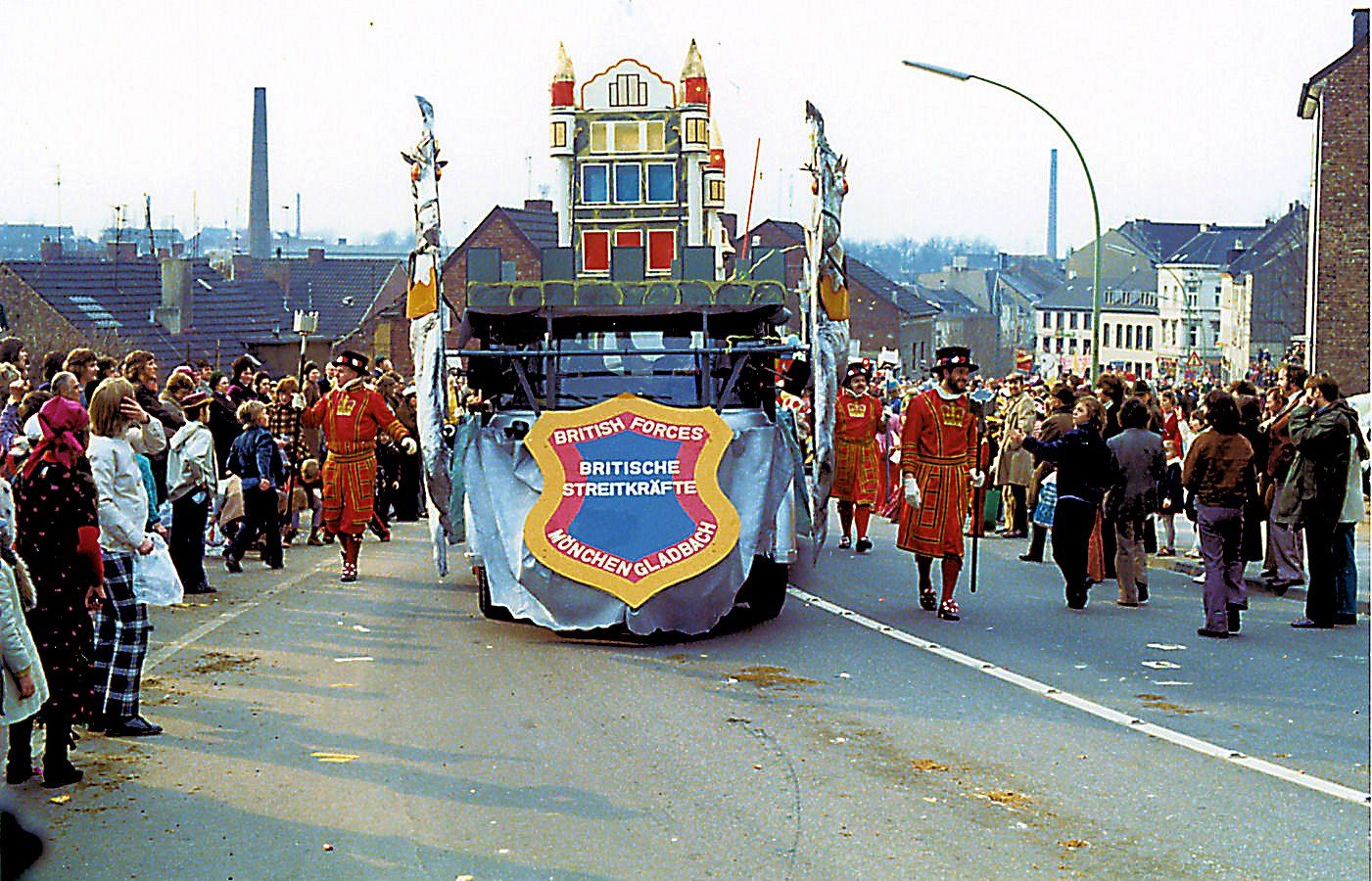
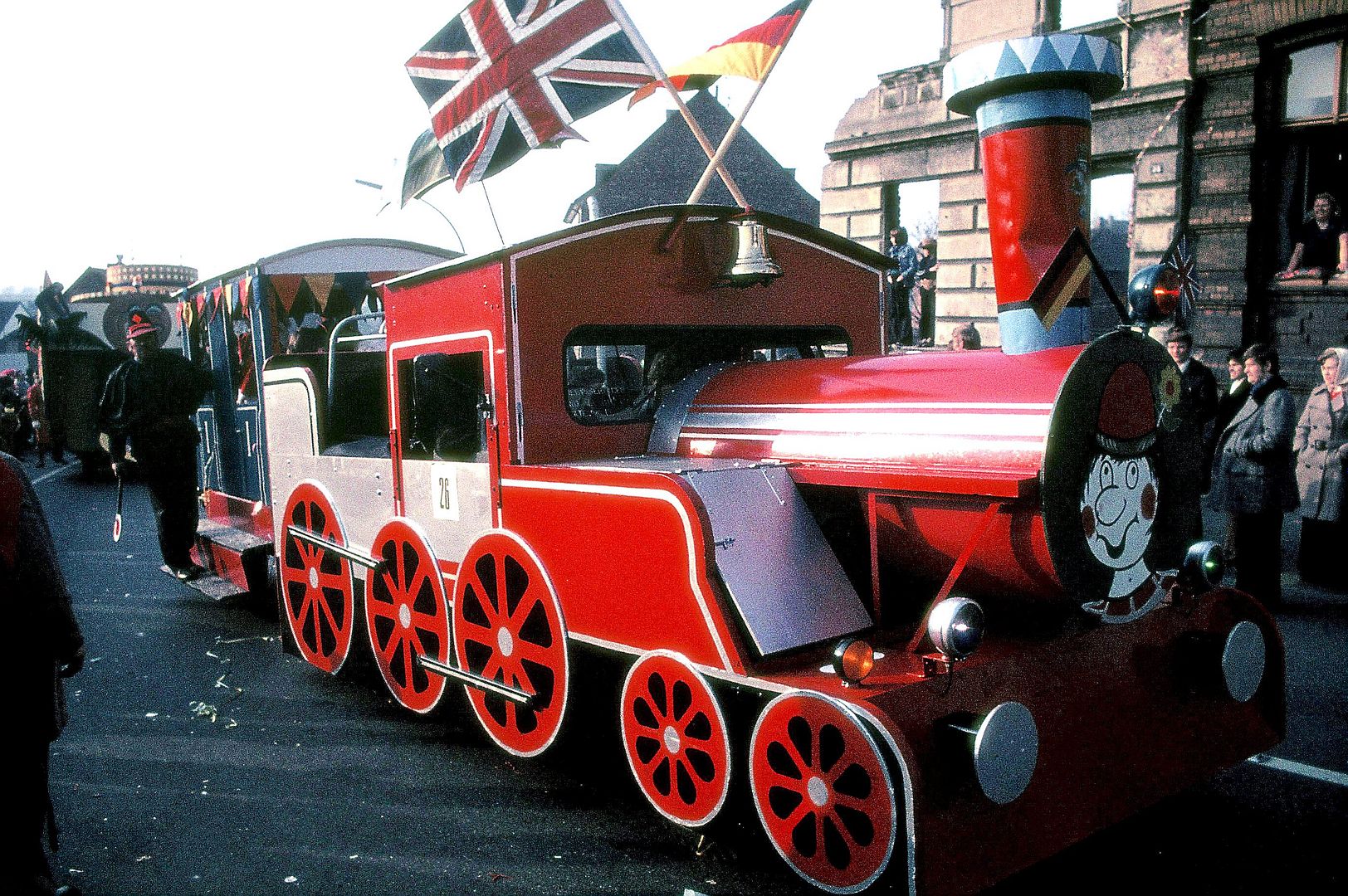
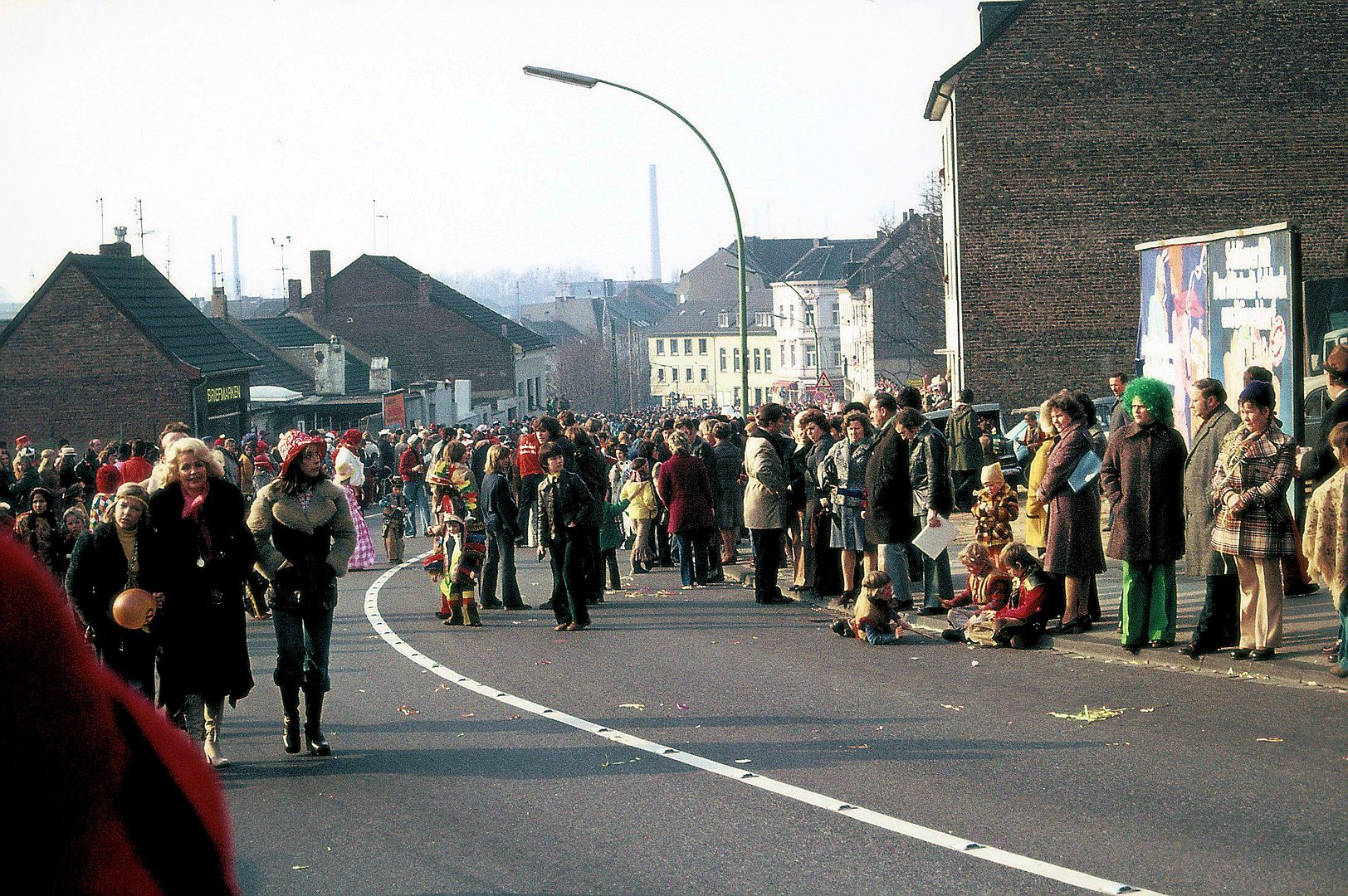
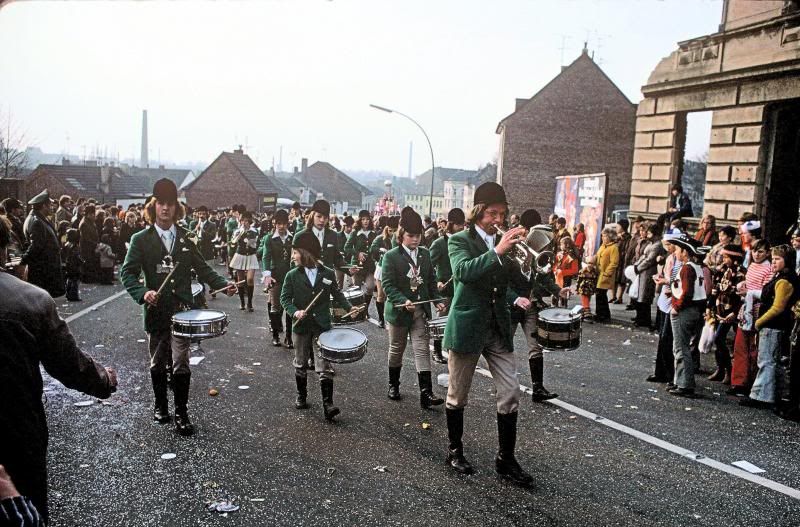
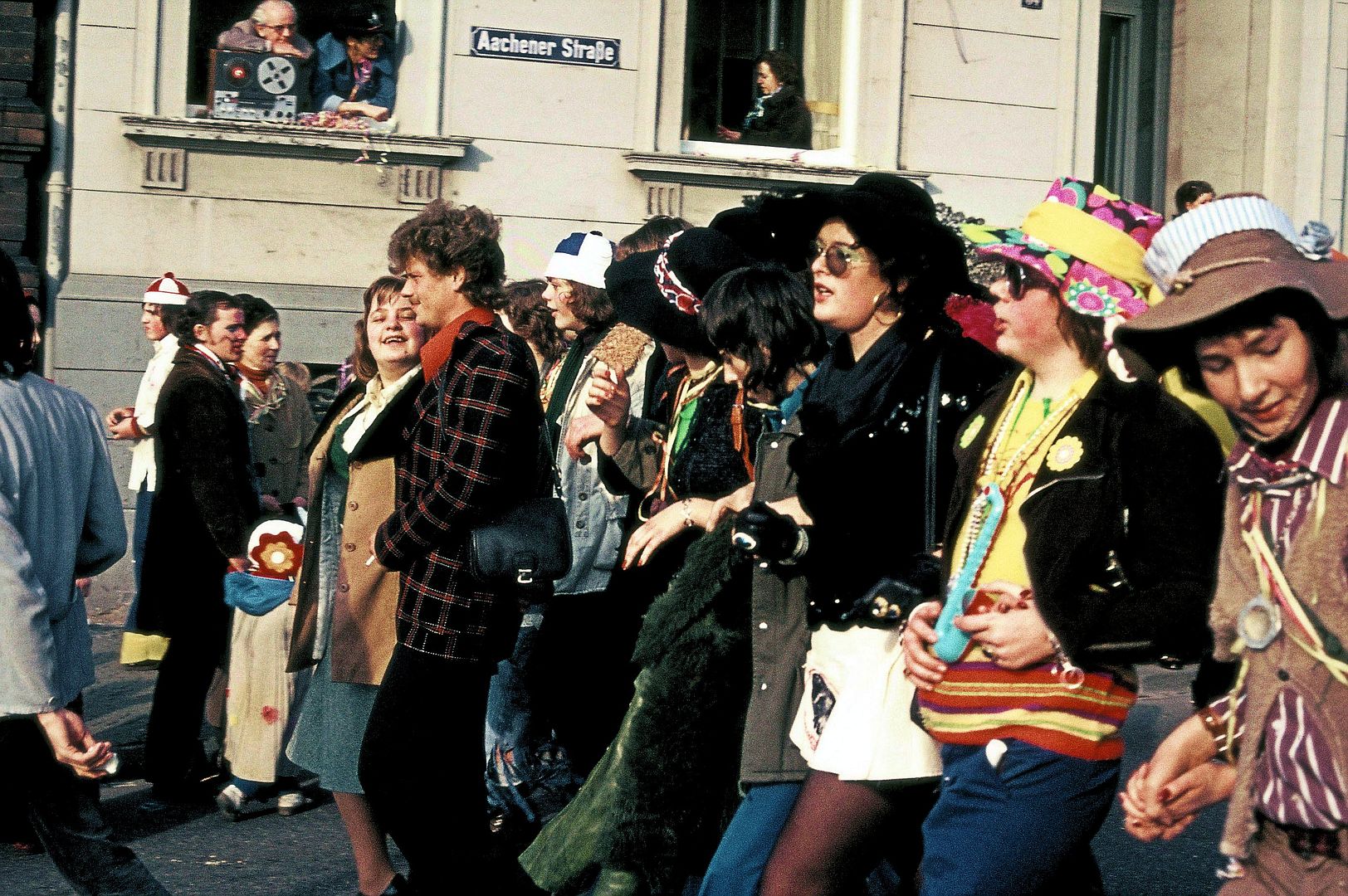
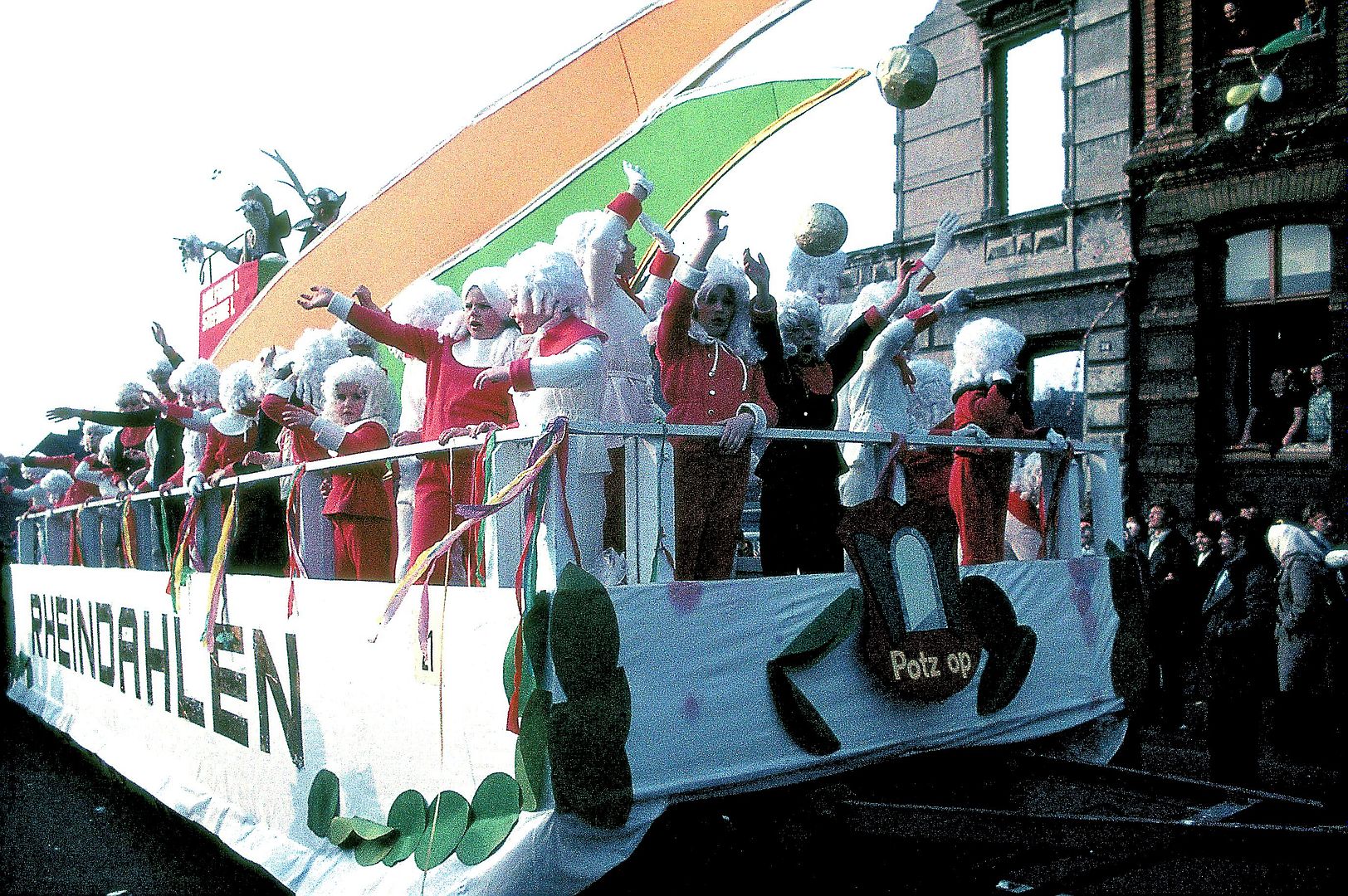
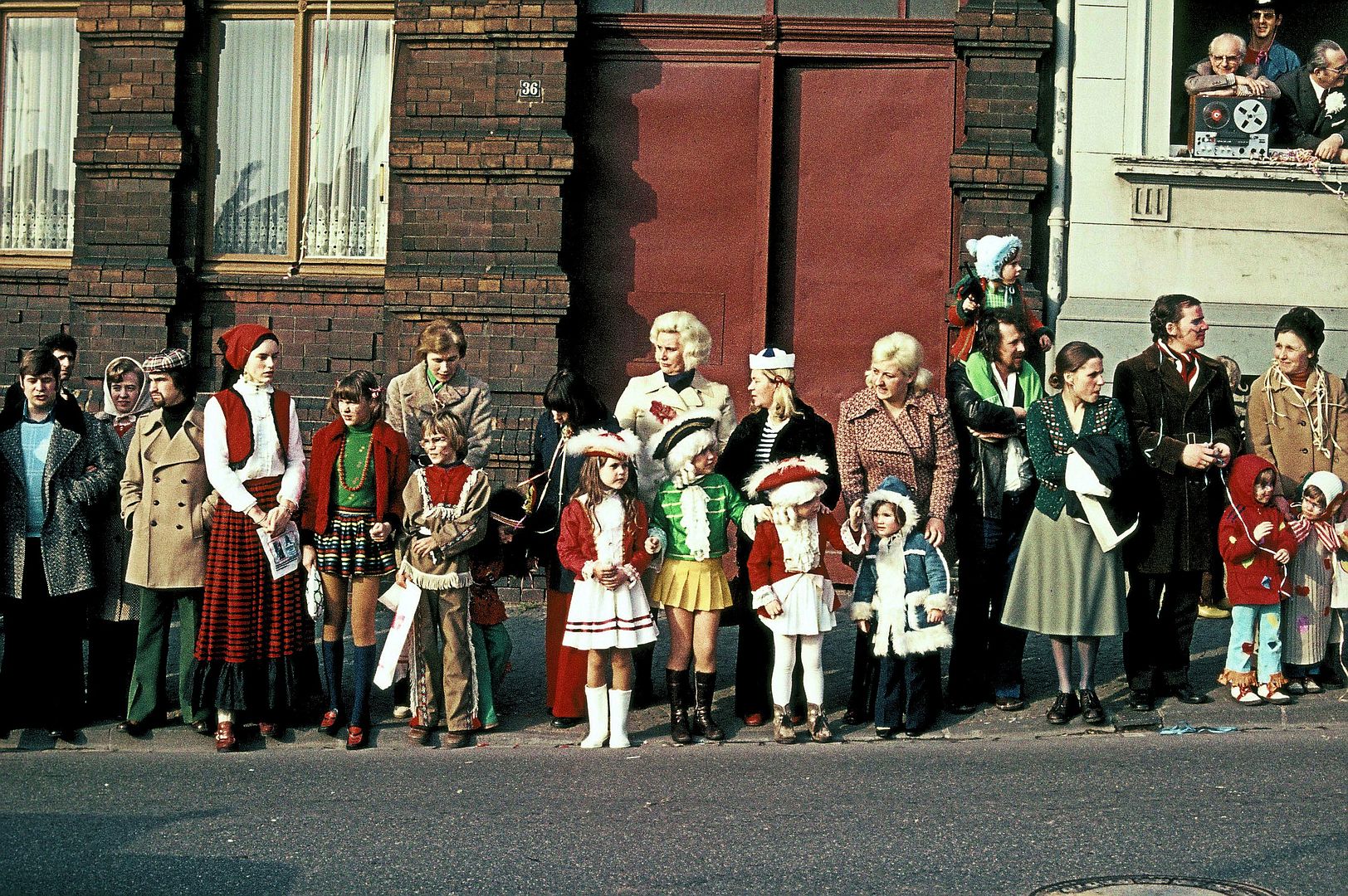
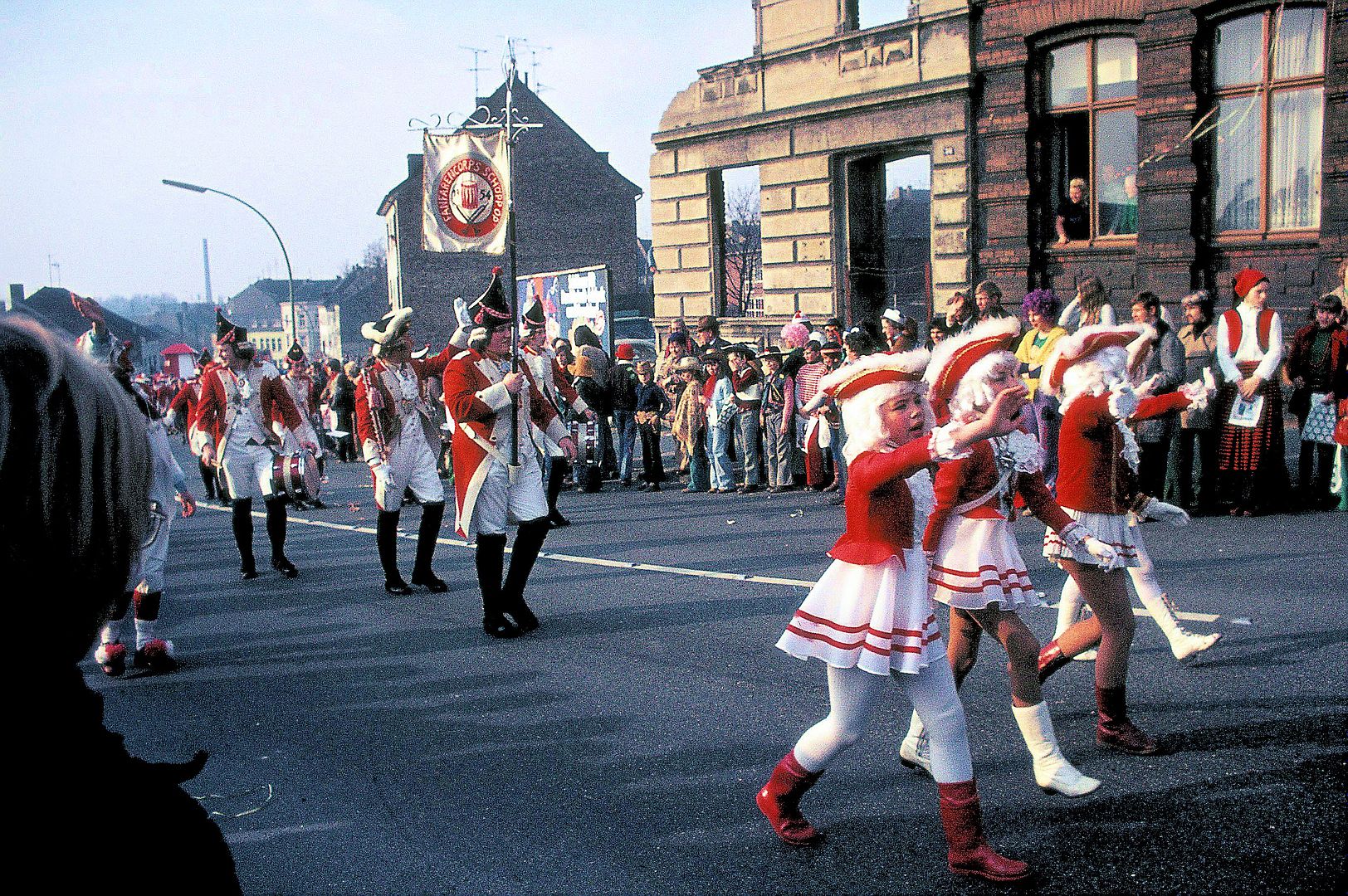
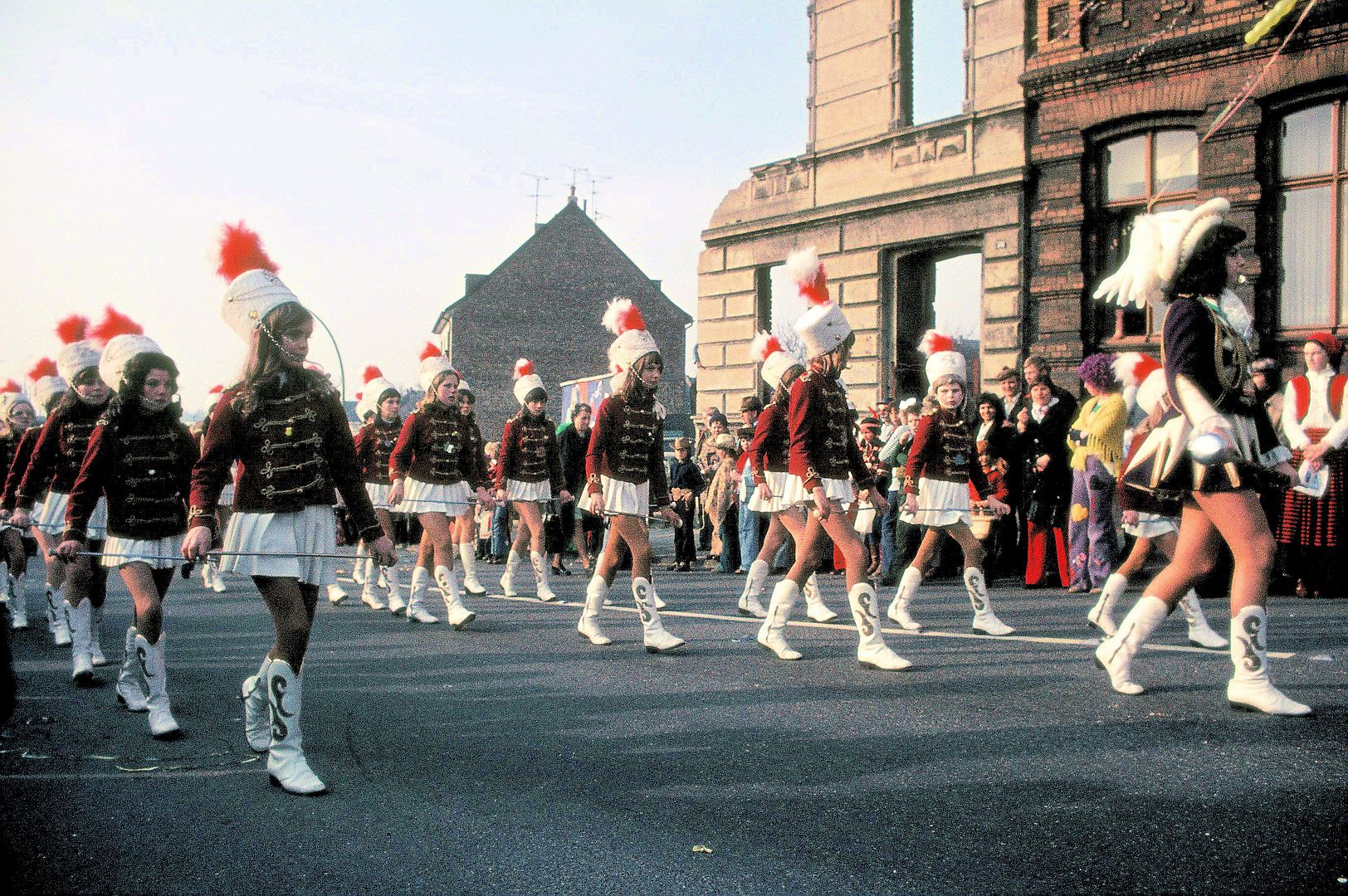

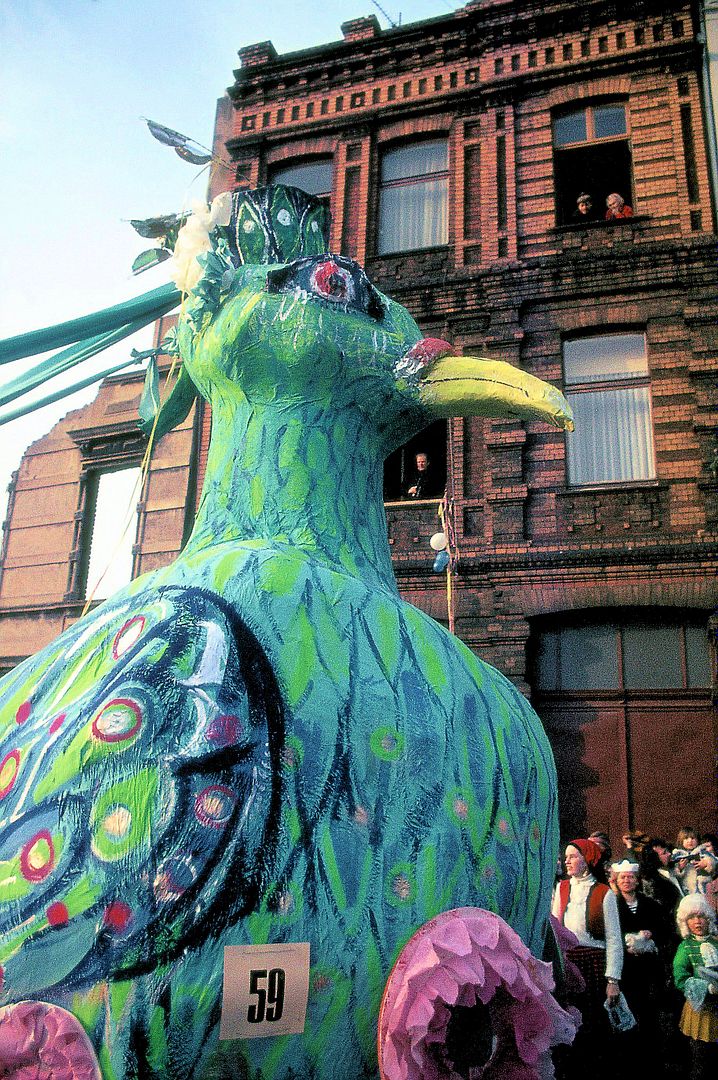
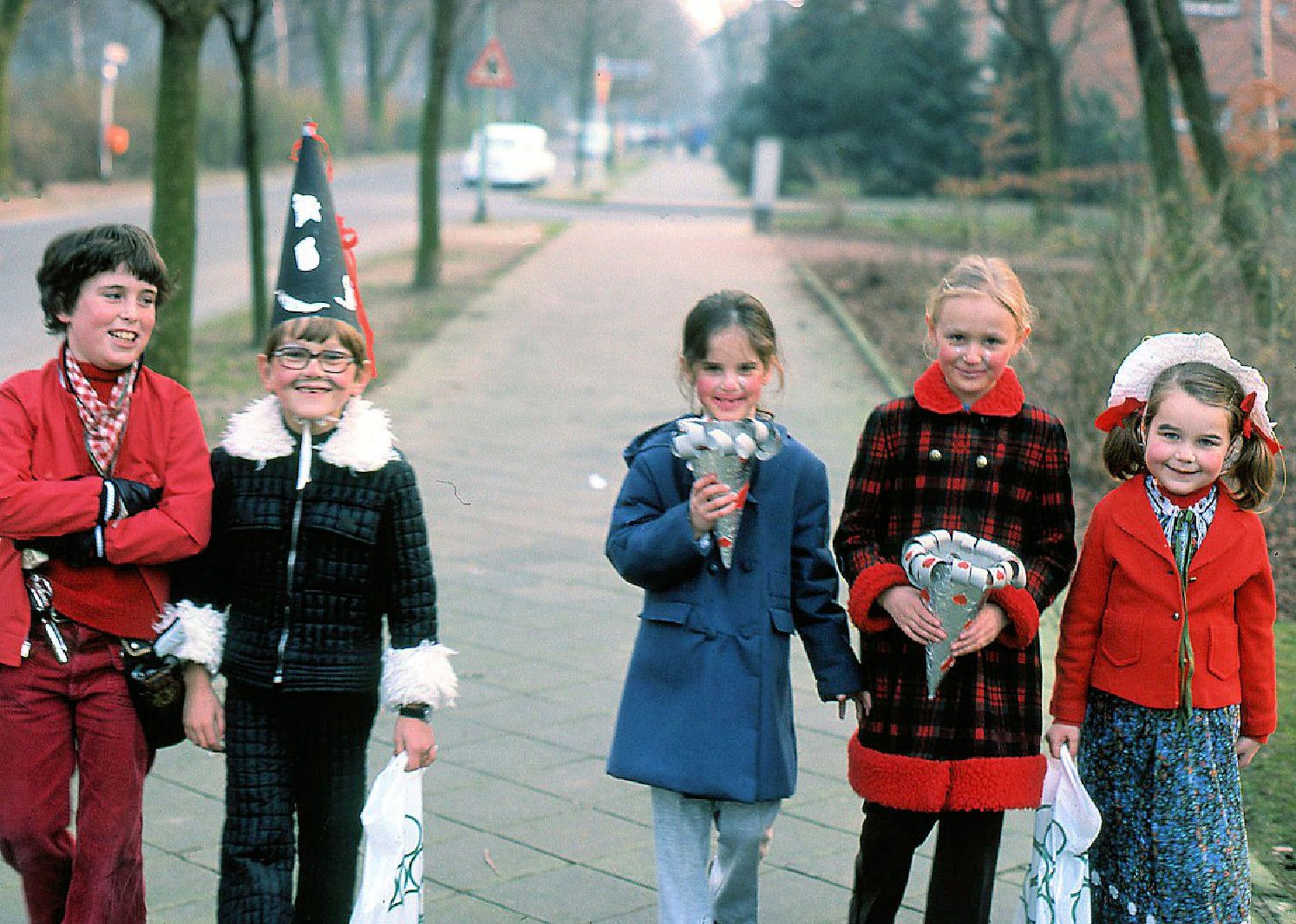

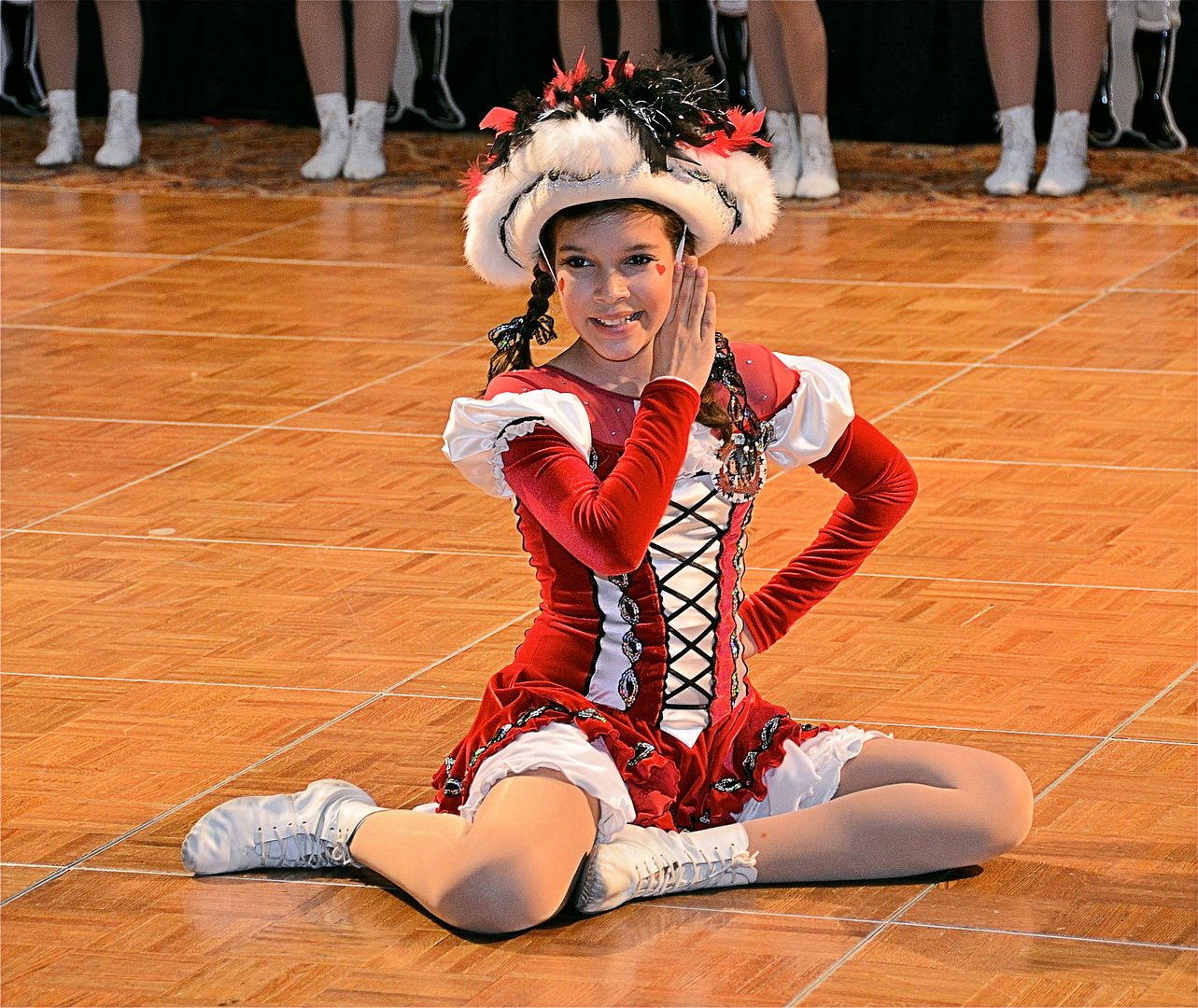
Danny in his earlier missives above provided a good background to R.A.F. service life in Germany in the 1960’s. However he didn’t mention Fasching or Karneval (Carnival) that made for a refreshing change of mood for what we Brits perceived as the sometimes very serious disposition of many Germans in the towns and cities in the Rhineland and the ones we worked alongside at JHQ.
So the start of Lent next week reminds me of the habit in towns in the Rhineland to hold their carnival processions. In the big towns or cities such as Cologne or Dusseldorf Rosenmontag (Rose Monday) is the highlight of the German “Karneval” (carnival) season and is on the Monday before Ash Wednesday. Celebrations become quieter the next day, known as Veilchendienstag (“Violet Tuesday”, (Shrove Tuesday)), and end on "Aschermittwoch” (Ash Wednesday). Monchengladbach’s carnival procession titled Veilchendienstagszug (Violet Tuesday Train) traditionally takes place on the Tuesday and JHQ some other units in the area treated the day as a holiday so we all had the day off, which was ideal as the BFG School was closed too and the kids had the day off as well and were keen to participate in the celebrations.
Traditionally, as I recorded alongside the photos in my photo album, the 1973 carnival procession consisted of 80 floats, 30 marching bands, and 24 dance troupes. I took my kids and a couple of neighbours kids from our MG married quarter patch to enjoy the procession – forewarned that kids should have bags to catch the sweets (Kamelle) thrown from the carnival floats into the crowds lining the streets among cries of “Helau” or “Alaaf”. The kids were not disappointed and came back well laden. Mum was also rewarded because flowers (tulips) were thrown into the crowd too. As seen the kids were dressed and made up to blend in with the German crowd.
Many girls in the parade “Tanzmariechen” or “Funkenmariechen” (marching girls) wear a very fetching uniform styled outfit. This consists of a very short skirt copied from 18th Century designs. Originally worn as jacket and trousers the trousers evolved into a short dress with a pleated skirt and very frilly knickers (to maintain their modesty as they “high-kicked” their legs through town). A wig with braided pigtails was worn and on top of that a Tricorn hat. White boots finished off the outfit.
Many of the dancers (“fools”) perform energetic dances emulating St Vitus, whose name is given to the Monastery after which Mönchengladbach is named. The Monastery of St. Vitus is a large Roman Catholic Church / Abbey set high on a hill overlooking the town. The Karneval traditionally has floats of “fools” or troops of dancers who emulate St Vitus in their mad dancing. According to legend, if suffering from various ailments one would say a prayer to the early Christian martyr St Vitus, and your prayer would be answered. St Vitus is reputed to have miraculous healing powers especially for those suffering from seizures, epilepsy, rabies, Sydenham’s chorea (St Vitus Dance), bedwetting, and snakebite, he is also said to protect against lightning strikes, animal attacks and oversleeping! To add to his attributes he is the patron saint of pharmacists, innkeepers, brewers, wine makers, coppersmiths, dancers and actors.
As for military participation in the procession JHQ Rheindahlen was represented by a float as was 79 Sqn Royal Corps of Transport based at Ayrshire barracks in Moenchengladbach. 79 Sqn RCT was responsible for administering the British Military Train “The Berliner” that at the time ran through the Soviet Zone to Berlin, they were also responsible for the various military ambulance trains positioned in sidings at R.A.F. Wildenrath. The RCT “float” was appropriately in the form of a locomotive sporting a Union Jack.
Carnival preparations traditionally begin in November with the election of officials etc. to run the carnival. The carnival celebrations proper kick off just before Lent with the “Women’s Carnival” on the Thursday of the week before Ash Wednesday. This is a special day for women called “Altweiber” (Old Women) or “Weiberfastnacht” (Women’s Day). On this day women are allowed to kiss any man they like as long as they cut off his tie beforehand (Tip: Beware any mad-looking women wielding a pair of scissors!) unless of course you fancy the lady in question in which case wear a very old tie!
German friends tell me Weiberfastnacht has morphed into a more modern form as an excuse for the women to go out by themselves for a girl’s only night out, leaving the kids at home with their men.














Guest
Posts: n/a
Danny says "Vive les Pompiers !"
At that time, RAF Catterick was still a working airfield, although mostly only communication types for the RAF Regiment depôt (but we had little to do with them), and from time to time ex-operational and transport aircraft were ferried in at the end of their working lives. I was always a bit sorry for these quite serviceable aircraft as they touched down for the very last time - they were destined to serve again, but only as fire rescue fuselages and at last, as fire hulks. Some crash carcases came in on low loaders (the "Queen Marys") - that wasn't so bad.
Of course, only the "proper" fire tradesmen on their Courses were allowed to practise on these, and not amateurs like us. There was a good deal of classroom work, most of which I've forgotten, but we must have been instructed in the chemistry of fires, much about the best methods of tackling the various kinds of fires, all about domestic fire extinguishers, fire hydrants (all I remember is that the big "T" keys worked the opposite way from the domestic tap), etc, etc.
The things I recall best were all on our practical training. Our fires were all small scale, a half-inch of avtur or avgas in a large drip tray, and we soon saw the importance of killing a fire before the container it was in (our tray or a wing or fuselage) gets hot, for when it rises to the flash point of the fuel, the fire will always strike back at you. It is not generally realised how dangerous petrol vapour really is, and how far it can travel. Nowadays the sight of a lit cigarette at a filling station would arouse instant horror and uproar, but a generation or two ago we were much more careless; people would puff their pipes, or have a cigarette stuck to the lip as they filled up, and no one would bother.
A never failing source of amusement (for the bystanders !) was the fireman's pole. It all looks so simple and easy when you see it done for real or on film, but when it comes to your turn to follow the instructor's demonstration, it's a different matter altogether ! Even a one-storey descent (and in some stations there are, I'm told, three or more floor descents), you're fifteen feet or more above ground - and you know what it's like at the top of the five-metre board for the first time.
In fact, when you step out into the void, inertia will hold you in position quite comfortably for the fraction of a second it takes to snuggle into your smooth 4-in pole and wrap your legs round it (these are your brakes, if you use ungloved hands for the purpose you'll likely get "pole burn"). But this is not natural; many a tyro, launching himself out at his pole with the courage of despair, has been known to suffer a broken nose, or lose a tooth as he goes at it like a bull at a gate.
Still more enjoyment (but not for the pretend "victim") may be derived from practice on a piece of life-saving equipment so good, so simple, so relatively cheap and so foolproof * that I wonder why fire safety regulations do not require it to be fitted under an external window sill on every floor of a multi-storey building above the first (and there's a case for that, too - many a house dweller has been overcome by smoke inhalation before someone can get a ladder up to the bedroom window).
It must have a trade name (but I don't know it). It works like this: you start with a man-carrying steel cable (or nylon would do, I suppose), the length of window sill to ground. A simple underarm strop is fixed to each end. The cable takes several turns round the wheel of a pulley anchored by a couple of feet of cable to a strong point under the inner sill. The pulley wheel has a centrifugal brake built in. (It's obvious now, isn't it ?).
Break out the kit, open the window, chuck out long end and strop, then the pulley block which will setlle just outside the sill. First out puts on strop and steps outside. Brake restricts him to something like parachute descent speed (10 ft/sec ?), though obviously the brake can be tailored to whatever speed you want. From a 100 ft building (say 8 stories), No.1's on the ground in 10 seconds, the other strop's up top, No.2 puts that on and away.
It works like a charm (I can vouch for that!): we had it at the top of the hose-drying tower (you mustn't put a hose away wet). Of course you must be careful to drop straight down, any attempt to launch off into space is going to swing you back hard against the wall. Even in the case of the eight storey building, no extendable turntable ladder could get up there, and if it could it couldn't take people out at anyway near the rate which this simple device can do.
One hazard remains, and we were explicitly warned of it. But there's always one who has to learn the hard way, isn't there ? You must watch your feet on the way down - for there's an empty strop coming up ! And it's coming up at 10ft/sec: you're going down at 10ft/sec, so...
He managed to get one leg in, the strop rode up (at about 14 mph, and he was a heavy chap): the resulting howl chilled the blood of all on the station and was heard in Catterick Village (over the other side of the old A1). Then he was trapped in the air midway; they had to lower a rope down to him so that he could hoist himself up a few inches to take the strain off the cables and enable him to get the leg free. After landing he waddled away rather stiffly, and was never the same man again (or at least not for quite a while !)
Moral: all of you young fellows, take heed of what your Instructor is telling you, and mock not his grey hairs, or the like may happen to you one day..
Goodnight, everybody.
Danny42C.
* "There is no such thing as a foolproof system - you only breed a new kind of fool".
Of course, only the "proper" fire tradesmen on their Courses were allowed to practise on these, and not amateurs like us. There was a good deal of classroom work, most of which I've forgotten, but we must have been instructed in the chemistry of fires, much about the best methods of tackling the various kinds of fires, all about domestic fire extinguishers, fire hydrants (all I remember is that the big "T" keys worked the opposite way from the domestic tap), etc, etc.
The things I recall best were all on our practical training. Our fires were all small scale, a half-inch of avtur or avgas in a large drip tray, and we soon saw the importance of killing a fire before the container it was in (our tray or a wing or fuselage) gets hot, for when it rises to the flash point of the fuel, the fire will always strike back at you. It is not generally realised how dangerous petrol vapour really is, and how far it can travel. Nowadays the sight of a lit cigarette at a filling station would arouse instant horror and uproar, but a generation or two ago we were much more careless; people would puff their pipes, or have a cigarette stuck to the lip as they filled up, and no one would bother.
A never failing source of amusement (for the bystanders !) was the fireman's pole. It all looks so simple and easy when you see it done for real or on film, but when it comes to your turn to follow the instructor's demonstration, it's a different matter altogether ! Even a one-storey descent (and in some stations there are, I'm told, three or more floor descents), you're fifteen feet or more above ground - and you know what it's like at the top of the five-metre board for the first time.
In fact, when you step out into the void, inertia will hold you in position quite comfortably for the fraction of a second it takes to snuggle into your smooth 4-in pole and wrap your legs round it (these are your brakes, if you use ungloved hands for the purpose you'll likely get "pole burn"). But this is not natural; many a tyro, launching himself out at his pole with the courage of despair, has been known to suffer a broken nose, or lose a tooth as he goes at it like a bull at a gate.
Still more enjoyment (but not for the pretend "victim") may be derived from practice on a piece of life-saving equipment so good, so simple, so relatively cheap and so foolproof * that I wonder why fire safety regulations do not require it to be fitted under an external window sill on every floor of a multi-storey building above the first (and there's a case for that, too - many a house dweller has been overcome by smoke inhalation before someone can get a ladder up to the bedroom window).
It must have a trade name (but I don't know it). It works like this: you start with a man-carrying steel cable (or nylon would do, I suppose), the length of window sill to ground. A simple underarm strop is fixed to each end. The cable takes several turns round the wheel of a pulley anchored by a couple of feet of cable to a strong point under the inner sill. The pulley wheel has a centrifugal brake built in. (It's obvious now, isn't it ?).
Break out the kit, open the window, chuck out long end and strop, then the pulley block which will setlle just outside the sill. First out puts on strop and steps outside. Brake restricts him to something like parachute descent speed (10 ft/sec ?), though obviously the brake can be tailored to whatever speed you want. From a 100 ft building (say 8 stories), No.1's on the ground in 10 seconds, the other strop's up top, No.2 puts that on and away.
It works like a charm (I can vouch for that!): we had it at the top of the hose-drying tower (you mustn't put a hose away wet). Of course you must be careful to drop straight down, any attempt to launch off into space is going to swing you back hard against the wall. Even in the case of the eight storey building, no extendable turntable ladder could get up there, and if it could it couldn't take people out at anyway near the rate which this simple device can do.
One hazard remains, and we were explicitly warned of it. But there's always one who has to learn the hard way, isn't there ? You must watch your feet on the way down - for there's an empty strop coming up ! And it's coming up at 10ft/sec: you're going down at 10ft/sec, so...
He managed to get one leg in, the strop rode up (at about 14 mph, and he was a heavy chap): the resulting howl chilled the blood of all on the station and was heard in Catterick Village (over the other side of the old A1). Then he was trapped in the air midway; they had to lower a rope down to him so that he could hoist himself up a few inches to take the strain off the cables and enable him to get the leg free. After landing he waddled away rather stiffly, and was never the same man again (or at least not for quite a while !)

Moral: all of you young fellows, take heed of what your Instructor is telling you, and mock not his grey hairs, or the like may happen to you one day..
Goodnight, everybody.
Danny42C.
* "There is no such thing as a foolproof system - you only breed a new kind of fool".





